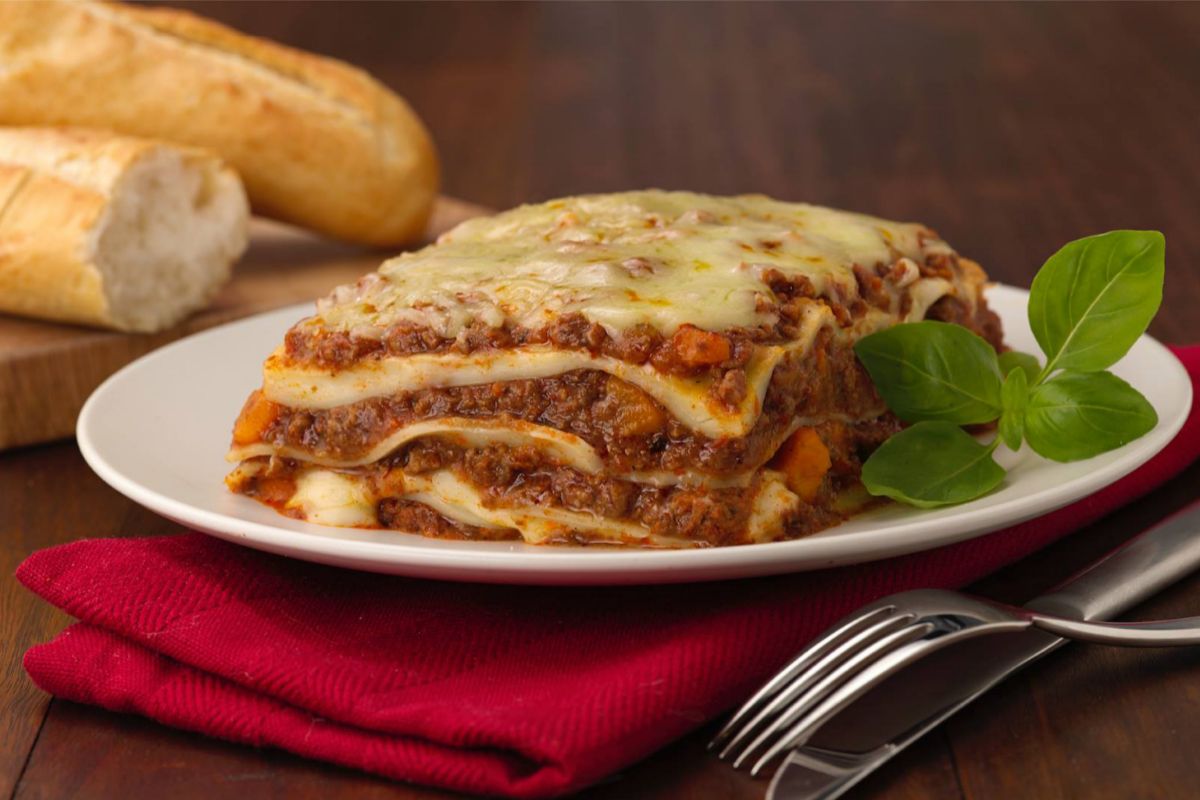Lasagna is a versatile, customizable, and filling dish that always goes down a treat!
There are several different types of lasagna, from traditional Bolognese sauce and cheddar to porcini mushrooms and béchamel. It’s one of the most popular Italian dishes and is a large part of Italian and Italian American cuisine.

Despite its popularity, one issue that’s frequently up for debate is how to layer the dish. So, how do you layer lasagna?
We’ll cover the answer in this post, including how many layers a lasagna should have, what order to layer the ingredients, and how to layer vegetable lasagna properly.
Number Of Layers In Lasagna
The number of layers in your lasagna varies based on the chef’s preferences. In theory, you could bake a lasagna with two layers, as this would be quick and won’t need a lot of baking time.
However, most people would view this as unsatisfactory. Most lasagna recipes need at least three layers. Anything below this would fail to resemble true lasagna.
If you’re deciding how many layers you want in your lasagna, you need to consider a few factors.
The first is the number of people you’re serving. Additional layers will give you extra servings. Remember that some people will want two servings, while others want less.
The second factor is how large your pan is. You want to avoid a thin, loose lasagna in a big pan, as well as an overstuffed smaller tray that explodes in your oven. We recommend a pan that’s big enough for six servings, which is around a 9 x 13” baking tray.
Cooking time also matters. If your lasagna has more layers, it will need extra time to cook in the oven. If you have a multilayered lasagna, but not enough cooking time, the core will remain raw and lead to an unpleasant dish.
Keeping this advice in mind, the best number of layers in a lasagna may be between three and five. This is enough to keep you full and satisfied, but not so many that the dish is difficult to make.
We also recommend checking how much sauce and pasta sheets you have, how large your baking dish is, and how many people you’re serving before you begin. This will give you an idea of how many layers your lasagna will need.
Feel free to experiment a little to see how many layers work best for you!
Correct Method To Layer Lasagna
You can layer a lasagna in whatever way you like, as there are several variations practiced all over the globe.
However, there are a few recognized rules involved with making a lasagna. Most lasagna recipes adhere to these guidelines, though there are always exceptions.
Before you start layering, make sure your tray has taller edges, as this prevents the filling from flowing out of the dish during baking.
This is the order in which to layer your ingredients:
1. Tomato Sauce Layer
To start, you’ll need to add an even tomato sauce layer. Italians tend to use bolognese sauce, though modern recipes may call for vegan sauce, or other variations.
You can use any type of sauce that you like, like pasta sauce, marinara, vegetable, or meat, as long as it has a tomato base.
The sauce needs to be the first layer, as this prevents the noodles from sticking to the baking tray’s base.
If you like extra cheesy lasagna, sprinkle a layer of mozzarella or Gouda slices over the sauce. You can also opt to add the cheese after the bechamel sauce layer later on. This helps the two ingredients fuse during baking.

2. Lasagna Noodles
After the tomato sauce, add the lasagna sheets or noodles over the sauce. The pasta should coat the full pan, so you can’t see the bottom.
3. Bechamel Sauce
Some people like to opt out of bechamel sauce, but we’d recommend using it for an authentic Italian flavor.
Bechamel sauce is made with butter, milk, flour, and ground nutmeg. The mix of this white sauce with the tomato sauce base creates a creamier, more decadent dish.
The two sauces also infuse into the pasta, increasing the flavors within the lasagna. If you’re making bechamel sauce at home, remember to cook it slowly, as this helps form a thicker sauce.
4. Repetition
Once you’re done with the bechamel sauce layer, repeat the steps, starting with the tomato sauce layer.
You can repeat this process as many times as you want, creating several layers of red sauce, pasta, and white sauce. Once you’re done with the last layer, top the dish with a sprinkle of your chosen cheese.
As mentioned above, if you prefer a cheesier dish, you can add the cheese after the tomato or bechamel sauce layer. If not, simply leave the cheese until last.
The steps outlined here are basic guidelines, but you can customize this method any way you like. For instance, you can add a layer of vegetables after the sauce layer, or swap the pasta layers for eggplant or zucchini slices.
The possibilities are endless, but always remember to avoid overfilling your baking tray!
Layering Vegetable Lasagna
Layering a vegetable lasagna involves the same techniques outlined above. It’s best to slice the vegetables into smaller pieces, as this ensures that they cook through in the oven.
You’ll also need to mix chopped vegetables and grated cheese beforehand in a separate bowl.
Follow these steps to layer vegetable lasagna:
- Begin by layering an even layer of tomato sauce at the base of the tray. This prevents the lasagna’s pasta layer from sticking to the tray’s base.
- Top the sauce with a layer of lasagna noodles or sheets. Always overlap the pasta’s edges so there are no spaces. This makes the dish easier to serve when it’s done.
- Next, add the vegetable and cheese blend over the pasta. Use a spoon to evenly spread the mixture.
- Repeat the steps three to four times to form a multi-layered dish.
- Once you’re done, top with any remaining sauce and sprinkle a generous layer of cheese.
- Bake in the oven for around 25 minutes or until the cheese topping bubbles. You’re done!
Final Thoughts
The steps above show you how to layer a lasagna, but remember that this is just a guideline.
You can layer your ingredients in any way you want, but we’d always recommend starting with a layer of sauce. This will stop the pasta layer from drying out at the bottom, which can be very hard to clean later on!
We hope you have fun experimenting with lasagna layers at home!
- How To Reheat A Cheesesteak - November 5, 2023
- What Are Three Must Have Kitchen Knives? - September 22, 2023
- How To Protect Edges Of Pie Crust - June 15, 2023








